
How to Pick the Perfect Tank Water Heater
In Yellowstone National Park, there's a geyser known as "Old Faithful" for its regular and fairly predictable eruptions of hot water. Similarly, in most American homes, you'll find the good, old faithful storage tank water heater, which sends hot water to our showers and dishwashers (but hopefully doesn't erupt).
Hot water tanks usually don't cross most people's minds and aren't maintained. That is until they fail and you get a frigid dose of reality in the shower or a flooded room - when it's too late! Then you ask, how do I replace my water heater?
At that point, a new water heater becomes a priority. That's why, if your tank is showing any signs of deterioration, I highly recommend looking for a new water heater now. To help, here's everything you need to know about how to find the right tank-style water heater."
Replacing an Existing Water Heater Tank
If you already have a hot water storage tank, the simplest thing you can do is replace it. The best place to start is by looking at the yellow EnergyGuide water heater label on your existing unit.
Understanding Your Water Heater Label
All water heaters in the U.S. come with the yellow EnergyGuide label, which provides vital information on the type of water heater you have and its capacity. The capacity indicates the water heater's first hour rating, which represents how many gallons of hot water the unit can provide in one hour.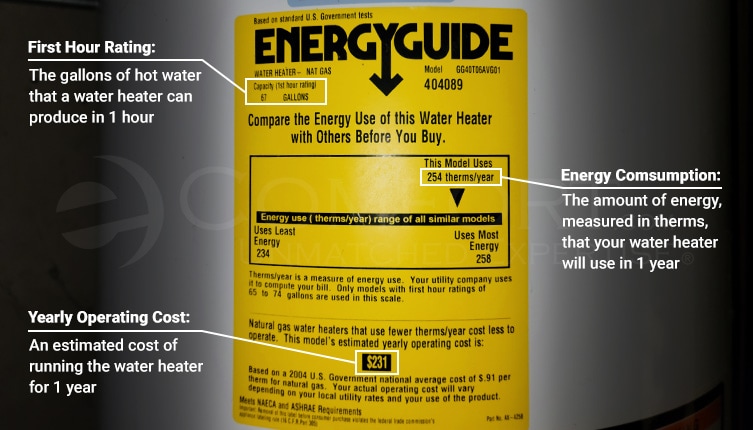
This first hour rating is the single most important number to know when buying a new tank water heater. The good news is, if you're happy with how much hot water your current heater produces, then all you need to do is replace it with a similarly sized unit.
Other valuable information you'll find on the EnergyGuide label is the unit's energy consumption (measured in therms per year) and its estimated yearly operating cost. This is useful in determining how energy efficient your existing water heater is compared to new ones you can get.
How to Pick a New Water Heater Style
If you're putting a storage tank water heater in a house for the first time or are looking to change things up, then you have a few more decisions to make. First, do you even want a storage tank unit, or are you interested in other types of water heaters on the market, like tankless.
If you are set on a hot water storage tank, then you need to choose between gas and electric models. Typically, gas-powered units cost more upfront but less to operate, while electric water heaters are less expensive upfront but are more costly to run. Electric units are still more efficient overall because they don't lose heat to combustion like gas units. Learn more about how water heaters work.
High Efficiency Water Heaters
High efficiency gas hot water heaters have improved insulation, use modulating burners, and are better overall at capturing and using the heat they generate. For example, some high efficiency condensing gas water heaters use a secondary heat exchanger that extracts heat from the combustion gases to help heat the water, meaning that less heat is lost out of the vent.
A second benefit of these high efficiency condensing models is that, because they extract more heat from the combustion gases, those gases become cooler and can be vented out using less expensive piping. With standard efficiency water heaters, you must use more expensive stainless-steel venting that can withstand the high exhaust gas temperatures.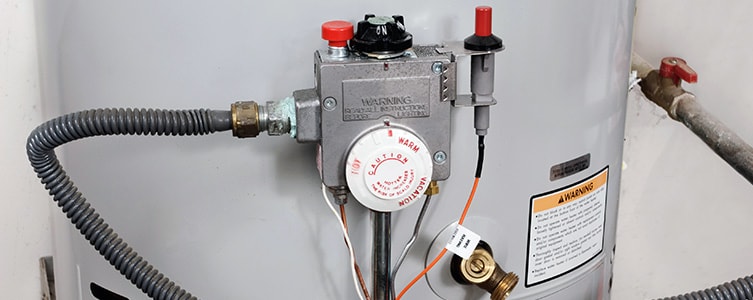
How do you know if a water heater holding tank is highly efficient? You need to look at its Uniform Energy Factor (UEF). UEF is expressed as a percentage and is calculated by dividing the amount of energy used to heat the water by the total amount of heat produced by the water heater. In effect, it measures how much heat is used productively rather than being wasted.
Any water heater tank with a UEF of above 90% is considered highly efficient. These water heaters use 90% of their energy to heat your water and waste only 10%. Put another way, for every dollar of fuel used, only 10 cents are wasted versus 11-20 cents for standard efficiency units.
Although these units will be more expensive upfront than standard efficiency heaters, they will save you 10%-20% in energy, according to the Environmental Protection Agency (EPA). The EPA also reports that this can save you up to $500 over the course of the water heater's life.
The most efficient types of storage tank water heater are electric heat pump and solar models. Electric heat pump water heaters extract heat from the surrounding space to warm up the water inside (this also helps dehumidify and cool the air). They can save 65% of energy compared to traditional electric resistance water heaters, according to the EPA.
Solar water heaters with an electric backup can provide you with 70%-90% energy savings and convert the sun's thermal energy into hot water. If the sun isn't out, an electrical backup system kicks in to provide the necessary heat.
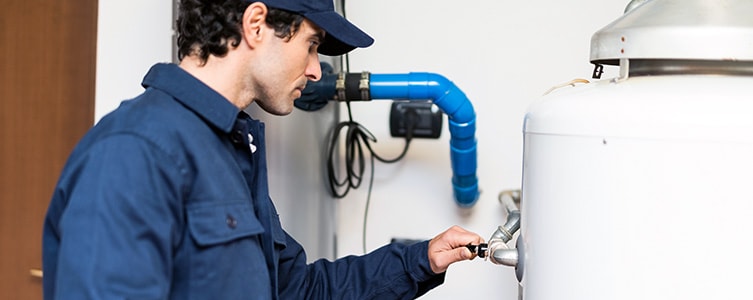
What Size Water Heater Tank Do I Need?
To find the right size water heater tank for your home, you need to match its first hour rating with the most amount of hot water you ever use in an hour, called peak hour demand. Remember, the first hour rating is how many gallons of hot water the water heater can produce in one hour.
- Figure out the time of day your household typically uses the most hot water. For example, maybe it's in the morning when you and your spouse both take a shower before going to work.
- Estimate the number of gallons of hot water used during that busy hour. The table below provides average gallon usage per common household water activities. For example, if your household takes two showers in an hour, then you would take the average amount of gallons used per shower (20 gallons) and multiply them by 2 (20 gallons X 2 = 40 gallons).
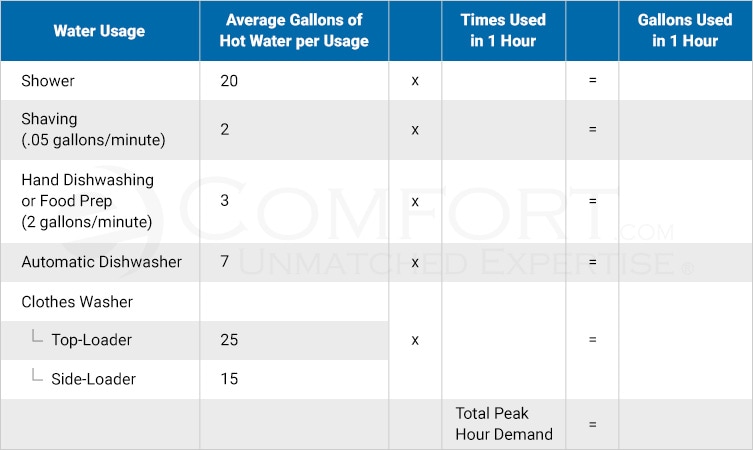
- Add up the number of gallons you use during your household's peak hour demand. Then, find a water heater with a first hour rating that at least matches this peak hour demand. Using the same example as above, you would need a water heater capable of providing at least 40 gallons of hot water in an hour. You might consider upsizing a bit if you think your hot water demand will rise in the future.
Hot water tank sizes range from 20-70 gallons, with 40 gallons being most common. One important note to consider is that, due to more stringent efficiency requirements from the U.S. Department of Energy, hot water storage tank manufacturers are adding extra insulation to their tanks. The result is that a 40-gallon water heater today will have slightly wider dimensions than 10 years ago. That means if you're trying to do a clean swap of an old 40-gallon water heater and have a tight space, the new one may not fit.
The other side of this coin is that high efficiency water heaters may have a first hour rating that is higher than the tank size. For example, you may have a 40-gallon tank, but it's efficient enough to produce 50 gallons of hot water in an hour.
Installing a Tank Water Heater
To preserve your manufacturer's warranty, avoid costly errors, and protect yourself from possible harm, you should have a licensed professional install your new storage tank water heater.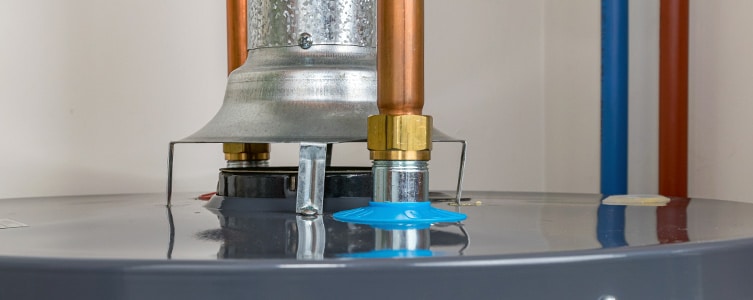
Your installer will also be familiar with your local building codes, which impact how an appliance can be installed. For gas hot water heaters, venting is one key consideration. Three venting styles exist for removing toxic exhaust gases from your home.
- Atmospheric, or chimney, venting pulls intake air from the surrounding space and uses the principle of hot air rising to naturally vent exhaust out your chimney. This method is more prone to backdrafting of exhaust, meaning the exhaust could flow back into your home under certain circumstances.
- Power venting pulls intake air from the surrounding space and uses a motorized fan to propel exhaust through a vent running straight out the side of the house. This eliminates the threat of backdrafting.
- Direct Venting pulls intake air directly from outside and uses a fan to propel exhaust through a vent running straight out the side of the house. Oftentimes, concentric pipe is used so that the intake air and exhaust can flow through the same opening. This is a preferred method because it guarantees fresh intake air enters and toxic exhaust leaves.
As you can see, venting your gas hot water heater is not a DIY weekend project. It should be undertaken only by a trained professional to prevent gas leaks.
How to Maintain Your Tank Water Heater
Once they have a water heater tank installed, most people don't touch it until it breaks. However, regular maintenance can significantly extend its life.
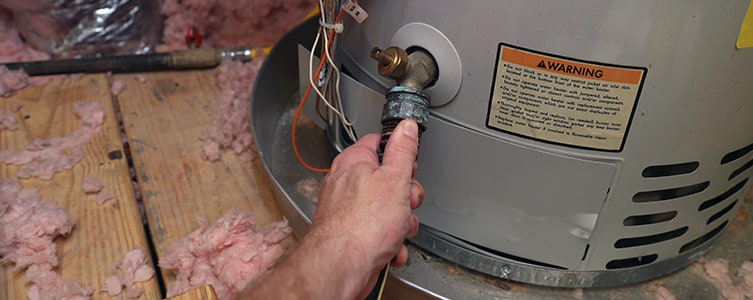
The primary enemy of water heaters is sediment caused by minerals in the water. This sediment builds up over time inside the tank, causes corrosion, and eventually results in leakage and system failure.
As built-in protection, all storage tank water heaters include an anode rod. This metal rod runs down the inside of the tank and attracts water sediment to itself so that the sediment does not build up on the actual tank walls. For this reason, it's often known as a "sacrificial" anode rod. Eventually, the anode rod is destroyed by corrosion, but it is replaceable. In fact, replacing your water heater's anode rod every couple of years is the easiest way to extend the heater's life.
Another form of protection against sediment buildup is to drain and flush your water heater tank annually. This helps clear some of the sediment so it will not accumulate as quickly.
To that point, try to select a water heater with a copper drain valve instead of a plastic one. Sediment accumulates quickly on the drain, causing a plastic one to easily break off. A metal drain should not break and will ensure you can continue flushing the heater over the course of its life.
Be sure to check your owner's manual for other necessary maintenance. Remember, some tasks, particularly ones involving working with the gas, should be done by a professional. We also recommend you install a working CO/Smoke detector near your water heater as added protection against a gas leak.
Find a Faithful Tank Water Heater
There is a reason Americans have trusted storage tank water heaters for so long. The confidence that you have hot water standing by for your shower and dishes is a priceless feeling that we take for granted. Finding the right water heater tank and taking care of it will preserve that feeling for years to come.
Water Heater Buyer's Guide Navigation
Home | Tank Water Heaters | Tankless Water Heaters | Point-of-Use Water Heaters | Indirect Water Heaters

